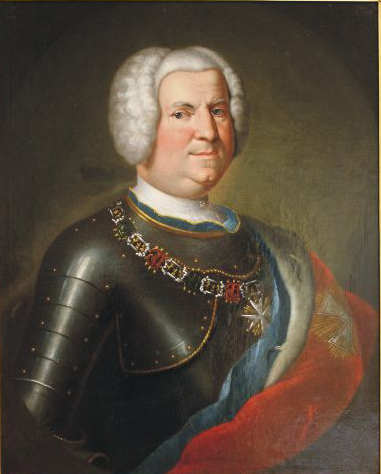by Susan Flantzer
Principality of Schwarzburg-Sondershausen: The County of Schwarzburg was a state of the Holy Roman Empire from 1195 to 1595, when it was partitioned into Schwarzburg-Rudolstadt and Schwarzburg-Sondershausen. The new counties remained in the Holy Roman Empire until its dissolution. In 1697, the County of Schwarzburg-Sondershausen was elevated to the Principality of Schwarzburg-Sondershausen. The County of Schwarzburg-Rudolstadt was elevated to the Principality of Schwarzburg-Rudolstadt in 1710.
The death of Karl Günther, Prince of Schwarzburg-Sondershausen without an heir in 1909 caused the Principalities of Schwarzburg-Rudolstadt and Schwarzburg-Sondershausen to be united under Günther Victor, Prince of Schwarzburg-Rudolstadt in a personal union. Following his succession in Sondershausen, Prince Günther Victor dropped the name Rudolstadt from his title and assumed the title Prince of Schwarzburg.
At the end of World War I, Prince Günther Victor was the last German prince to renounce his throne, abdicating on November 22, 1918. He made an agreement with the government that awarded him an annual pension and the right to use several of the family residences. The territory that encompassed the Principalities of Schwarzburg-Rudolstadt and Schwarzburg-Sondershausen is now located in the German state of Thuringia.
*********************

Credit – Wikipedia
Heinrich XXXV, Prince of Schwarzburg-Sondershausen is considered the most controversial Princes of Schwarzburg-Sondershausen. Born on November 8, 1689, he was the eldest of the five sons and the third of the eight children of Christian Wilhelm, Prince of Schwarzburg-Sondershausen and his second wife Wilhelmine Christiane of Saxe-Weimar (1658 – 1712).
Heinrich had seven siblings:
- Johanna Auguste (1686 – 1703), died in childhood
- Christiane Wilhelmine (1688 – 1749), unmarried
- August (1691 – 1750), married Charlotte Sophie of Anhalt-Bernburg, had six children including Christian Günther III, Prince of Schwarzburg-Sondershausen
- Henriette Ernestine (1692 – 1759), unmarried
- Rudolf (1695 – 1749), unmarried
- Wilhelm (1699 – 1762), unmarried
- Christian (1700 – 1749), married Sophie Christine Eberhardine of Anhalt-Bernburg-Schaumburg-Hoym, had five children
Heinrich had seven half-siblings from his father’s first marriage to Antonie Sybille of Barby-Mühlingen (1641 – 1684):
- Anton Albrecht(1674 – 1680), died in childhood
- August Wilhelm (1676 – 1690), died in childhood
- Günther XLIII, Prince of Schwarzburg-Sondershausen (1678 – 1740), married Elisabeth Albertine of Anhalt-Bernburg, no children
- Magdalene Sophie (1680 – 1751), married Count Georg Albert von Schönburg-Hartenstein, had seven children
- Christiane Emilie (1681- 1751), married Adolf Friedrich II, Duke of Mecklenburg-Strelitz (third wife), had two children
- Luise Albertine (1682 – 1765), unmarried
- Antonie Sibylle (born and died 1684), died in infancy
In 1713, a decree had been issued instituting primogeniture. The reigning Prince’s oldest son would be his sole successor, rather than having to share reigning with his younger brother(s) as Heinrich’s father did. This change meant that Heinrich would not be entitled to a share of Schwarzburg-Sondershausen. Greatly upset with this change and his entire family, Heinrich left the Principality of Schwarzburg-Sondershausen. He settled at a country estate in Bürgel, now in the German state of Thuringia, but then in the Duchy of Saxe-Weimar where Heinrich’s maternal uncle Wilhelm Ernst was the reigning Duke of Saxe-Weimar.
However, Heinrich eventually succeeded to the throne of the Principality of Schwarzburg-Sondershausen. The marriage of Heinrich’s half-brother Günther XLIII, Prince of Schwarzburg-Sondershausen produced no children. Upon his half-brother’s death on November 28, 1740, Heinrich became the reigning Prince of Schwarzburg-Sondershausen. Heinrich returned to Schwarzburg-Sondershausen where he lived at Schloss Sondershausen.
Heinrich’s Golden Coach; Credit – Wikipedia
Heinrich was emotionally distant from his subjects and often traveled outside his principality. He reveled in ostentatious displays of wealth. For example, he owned a hugely expensive collection of diamonds that gave him the nickname “Prince of Diamonds.” He owned 37 state coaches, including his Golden Coach (link in German), built in Paris, France in 1710, that is now on display in Schloss Sondershausen. Because of his strained relationship with his siblings, Heinrich left his personal possessions to Franz Josias, Duke of Saxe-Coburg-Saalfeld.
The Seven Years’ War (1756 – 1763), a global conflict for supremacy between Great Britain and France, began during the end of Heinrich’s reign and saw disputes between Prussia and Austria which affected the other Germanic monarchies. Heinrich gave no financial support to any forces in the war or any of his affected subjects. He preferred to spend his money on luxuries.
Heinrich never married. He died on November 6, 1758, aged 68, and his burial site is unknown. Because he had no children, he was succeeded by Christian Günther III, the eldest son of his younger brother August.
This article is the intellectual property of Unofficial Royalty and is NOT TO BE COPIED, EDITED, OR POSTED IN ANY FORM ON ANOTHER WEBSITE under any circumstances. It is permissible to use a link that directs to Unofficial Royalty.
Schwarzburg-Sondershausen Resources at Unofficial Royalty
- Unofficial Royalty: Principality of Schwarzburg-Sondershausen Index
- Unofficial Royalty: Royal Burial Sites of the Principality of Schwarzburg-Sondershausen
Works Cited
- De.wikipedia.org. 2020. Heinrich XXXV. (Schwarzburg-Sondershausen). [online] Available at: <https://de.wikipedia.org/wiki/Heinrich_XXXV._(Schwarzburg-Sondershausen)> [Accessed 11 November 2020].
- En.wikipedia.org. 2020. Henry XXXV, Prince Of Schwarzburg-Sondershausen. [online] Available at: <https://en.wikipedia.org/wiki/Henry_XXXV,_Prince_of_Schwarzburg-Sondershausen> [Accessed 11 November 2020].
- Flantzer, Susan, 2020. Royal Burial Sites Of The Principality Of Schwarzburg-Sondershausen. [online] Unofficial Royalty. Available at: <https://www.unofficialroyalty.com/royal-burial-sites/german-royal-burial-sites/royal-burial-sites-of-the-principality-of-schwarzburg-sondershausen/> [Accessed 9 November 2020].


































